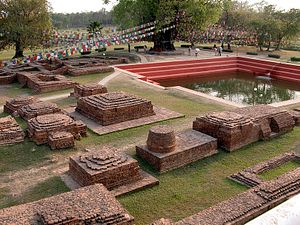Excavations at Nepal’s Lumbini pilgrimage center, among Buddhism’s most sacred sites and the birthplace of the Buddha, have revealed what archaeologists are calling the oldest Buddhist shrine in the world.
A wooden structure, hidden beneath the compound’s Maya Devi Temple, may date back to approximately 550 B.C. – a discovery that would push the Buddha’s birthday back by more than a century.
“What we have got is the earliest Buddhist shrine in the world,” said archaeologist Robin Coningham, lead author of the discovery study, according to National Geographic. “The big debate has been about when the Buddha lived and now we have a shrine structure pointing to the sixth century B.C.”
Though many Nepalese Buddhists believe that the Buddha was born in 623 B.C., many religious scholars contend that the Buddha lived and spread his teachings earlier – sometime in the fourth century B.C.
“Previous evidence of Buddhist structures at Lumbini went only as far back as the third century B.C.,” said NBC News. “The find is likely to add to Lumbini’s archaeological and religious importance as well.”
Lumbini, located in the Rupandehi District of central Nepal near its border with India, was certified as a UNESCO World Heritage Site in 1997. It is visited by more than one million of the religion’s 500 million global devotees each year.
The ancient timber shrine appears to be the inspiration for the brick Maya Devi Temple built on top of it – something that Coningham says could indicate a continuity of worship at the site. Even more intriguing is that the wooden structure features an open area where a tree once grew. Buddhists believe that their spiritual leader was born under a tree at the sacred Lumbini compound, making the newly discovered temple all the more significant.
Coningham and his colleagues used radiocarbon dating and optically stimulated luminescence techniques to establish a time period for pieces of charcoal, grain, and sand found within the hidden temple. Additional research confirmed the existence of tree roots beneath the structure’s open area.
The international team of archaeologists, overseen by UNESCO as well as Japanese and Nepalese officials, were given special permission to dig at Lumbini. Their research was conducted alongside prayers and meditation at the popular temple, which remained open to pilgrims throughout the excavations.
As is often the case when new evidence challenges widely accepted traditions, not everyone in the scientific community is ready to rewrite history.
“Archaeologists love claiming that they have found the earliest or the oldest of something,” archaeologist Ruth Young of the United Kingdom’s University of Leicester told National Geographic.
Julia Shaw, a University College London-based archaeologist, added that non-Buddhist rituals existed around the same time as early Buddhism.
“It would be difficult to determine whether the tree shrine in question was intended for the worship of the Buddha or was part of a distinct cultic context,” she told CNN.

































